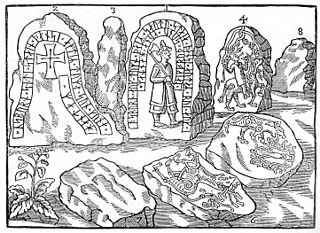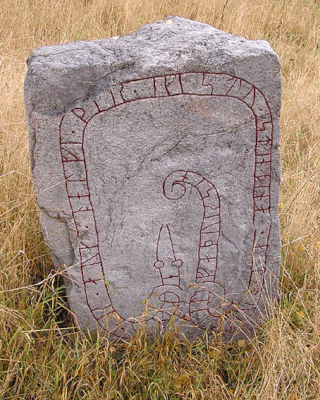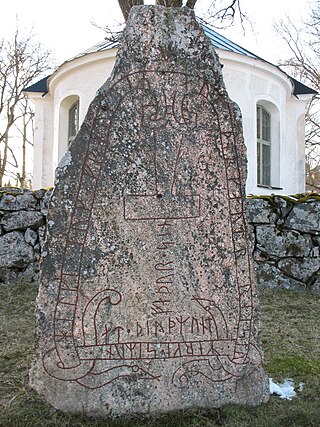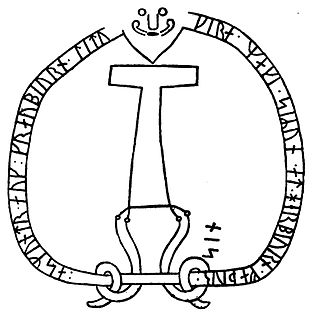

This Viking Age runestone, designated as G 181 in the Rundata catalog, was originally located at a church at Sanda, Gotland, Sweden, and is believed to depict the three Norse pagan gods Odin, Thor, and Freyr.


This Viking Age runestone, designated as G 181 in the Rundata catalog, was originally located at a church at Sanda, Gotland, Sweden, and is believed to depict the three Norse pagan gods Odin, Thor, and Freyr.

The runestone was discovered in the churchyard of Sanda church in 1863 [1] and is currently located in the Swedish Museum of National Antiquities. It is classified as being carved in runestone style Pr2, also known as Ringerike style.
The inscription depicts two scenes under an arching runic text band. The lower panel contains three figures, holding a spear, a hammer or club, and a sickle. Because the weapon of Odin was the spear Gungnir, that of Thor the hammer Mjöllnir, and Freyr is identified with farming, the figures have been identified as these three gods. [2] They are depicted wearing typical Viking Age clothing, including a cloak known as a hekla and a tasseled conical cap called a skott-húfa. [3] The upper scene also has three figures, which are considered to be the same gods; a large bird that may be a crane or goose is shown bending its head over the figure identified as Freyr. [4] Its meaning is not understood.
Some authorities have cited the runestone as evidence that Odin, Thor, and Freyr formed a divine Norse triad or trinity. [4] The proposition of this divine triad comes from theories of comparative religion and descriptions and depictions of these gods. [5] Other evidence for such a triad includes Adam of Bremen's description of the Temple at Uppsala as containing statues of these gods. [6] These three are also the only Norse gods known to have been actively worshipped during the Viking Age. [7]
The runic inscription is carved in the younger futhark and consists of three personal names. Björn (Old Norse Bjǫrn) was a common name meaning "bear"; Gunnbjǫrn translates as "Battle Bear" [8] and Farbjǫrn may mean "Far Traveling Bear".
The second line is a transliteration of the runes; the third is transcription into Old Norse.
:
:
ᚱᚬᚦᚢᛁᛋᛚ
roþuisl
Hróðvísl
:
:
ᛅᚢᚴ
aug
ok
:
:
ᚠᛅᚱᛒᚬᚱᚾ
farborn
Farbjǫrn
:
:
ᛅᚢᚴ
auk
ok
:
:
ᚴᚢᚾᛒᚬᚱᚾ
kunborn
Gunnbjǫrn.
:
:
Hróðvisl and Farbjọrn and Gunnbjọrn. [9]

In Norse mythology, Ragnarök is a foretold series of impending events, including a great battle in which numerous great Norse mythological figures will perish ; it will entail a catastrophic series of natural disasters, including the burning of the world, and culminate in the submersion of the world underwater. After these events, the world will rise again, cleansed and fertile, the surviving and returning gods will meet, and the world will be repopulated by two human survivors, Líf and Lífþrasir. Ragnarök is an important event in Norse mythology and has been the subject of scholarly discourse and theory in the history of Germanic studies.

A runestone is typically a raised stone with a runic inscription, but the term can also be applied to inscriptions on boulders and on bedrock. The tradition began in the 4th century and lasted into the 12th century, but most of the runestones date from the late Viking Age. Most runestones are located in Scandinavia, but there are also scattered runestones in locations that were visited by Norsemen during the Viking Age. Runestones are often memorials to dead men. Runestones were usually brightly coloured when erected, though this is no longer evident as the colour has worn off. The vast majority of runestones are found in Sweden.

The Jelling stones are massive carved runestones from the 10th century, found at the town of Jelling in Denmark. The older of the two Jelling stones was raised by King Gorm the Old in memory of his wife Thyra. The larger of the two stones was raised by King Gorm's son, Harald Bluetooth, in memory of his parents, celebrating his conquest of Denmark and Norway, and his conversion of the Danes to Christianity. The runic inscriptions on these stones are considered the best known in Denmark. In 1994, the stones, in addition to the burial mounds and small church nearby, were inscribed on the UNESCO World Heritage List as an unparalleled example of both pagan and Christian Nordic culture.

The Ledberg stone, designated as Ög 181 under Rundata, is an image-stone and runestone located in Östergötland, Sweden.

The Glavendrup stone, designated as DR 209 by Rundata, is a runestone on the island of Funen in Denmark and dates from the early 10th century. It contains Denmark's longest runic inscription and ends in a curse.

The Hunnestad Monument, listed as DR 282 through 286 in the Rundata catalog, was once located at Hunnestad at Marsvinsholm north-west of Ystad, Sweden. It was the largest and most famous of the Viking Age monuments in Scania, and in Denmark, only comparable to the Jelling stones. The monument was destroyed during the end of the 18th century by Eric Ruuth of Marsvinsholm, probably between 1782 and 1786 when the estate was undergoing sweeping modernization, though the monument survived long enough to be documented and depicted.

The Skåäng Runestone, designated as Sö 32 under Rundata, is an Iron Age runestone located in Skåäng, Södermanland, Sweden, which is inscribed in Proto-Norse with the elder futhark. During the Viking Age, a second runic inscription was added in Old Norse using the younger futhark.
The England runestones are a group of about 30 runestones in Scandinavia which refer to Viking Age voyages to England. They constitute one of the largest groups of runestones that mention voyages to other countries, and they are comparable in number only to the approximately 30 Greece Runestones and the 26 Ingvar Runestones, of which the latter refer to a Viking expedition to the Caspian Sea region. They were engraved in Old Norse with the Younger Futhark.
The Viking runestones are runestones that mention Scandinavians who participated in Viking expeditions. This article treats the runestone that refer to people who took part in voyages abroad, in western Europe, and stones that mention men who were Viking warriors and/or died while travelling in the West. However, it is likely that all of them do not mention men who took part in pillaging. The inscriptions were all engraved in Old Norse with the Younger Futhark. The runestones are unevenly distributed in Scandinavia: Denmark has 250 runestones, Norway has 50 while Iceland has none. Sweden has as many as between 1,700 and 2,500 depending on definition. The Swedish district of Uppland has the highest concentration with as many as 1,196 inscriptions in stone, whereas Södermanland is second with 391.

The Manx runestones were made by the Norse population on the Isle of Man during the Viking Age, mostly in the 10th century. Despite its small size, the Isle of Man stands out with many Viking Age runestones, in 1983 numbering as many as 26 surviving stones, which can be compared to 33 in all of Norway. So many of them may appear on the Isle of Man because of the merging of the immigrant Norse runestone tradition with the local Celtic tradition of raising high crosses.

Spånga Church is a church in the Spånga-Tensta borough in Stockholm, Sweden. It is part of Spånga-Kista Parish in the Diocese of Stockholm. The oldest part of the church originates from 1175–1200. Large reconstructions and enhancements took place during the 14th and 15th centuries.

Sö 194 is the Rundata designation for a runic inscription on a memorial runestone located in Brössike, which is about 12 kilometers northeast of Strängnäs, Södermanland County, Sweden, which was in the historic province of Södermanland. There are many such memorial runestones in Scandinavia. While the tradition of carving inscriptions into boulders began in the 4th century and lasted into the 12th century, most runestones date from the late Viking Age.

The Stenkvista runestone, designated as runic inscription Sö 111 in the Rundata catalog, is a memorial runestone located near the church at Stenkvista, which is two kilometers east of Skogstorp, Södermanland County, Sweden, which was formerly part of the historic Södermanland, and which features a depiction of Thor's hammer, Mjöllnir. This runestone is one of several runestones in Scandinavia that has a dedication to Thor. While the tradition of carving inscriptions into boulders began in the 4th century and lasted into the 12th century, most runestones in Scandinavia date from the late Viking Age.

This runic inscription, designated as U 448 in the Rundata catalog, is on a Viking Age memorial runestone located in Harg, which is about 4 kilometers north of Märsta, Stockholm County, Sweden, which was in the historic province of Uppland.

Sö 86 is the Rundata catalog number for a Viking Age memorial runic inscription located in Åby, which is about one kilometer north of Ålberga, Södermanland County, Sweden, and in the historic province of Södermanland. The inscription features a depiction of the hammer of the Norse pagan god Thor named Mjöllnir and a facial mask.

The Lund 1 Runestone, designated as DR 314 in the Rundata catalog, is a Viking Age memorial runestone originally located on the grounds of the All Saints Church in Lund, Scania, Sweden.

Södermanland Runic Inscription 270 or Sö 270 is the Rundata catalog number for a Viking Age memorial runic inscription. It is located in Tyresta National Park, Tyresta, which is about two kilometers east of Brandbergen, Stockholm County, Sweden, which is in the historic province of Södermanland.
The Bjärby Runestones are two Viking Age memorial runestones located near Grästorp, Sweden, in Bjärby synod, which was in the historic province of Västergötland. The two stones are memorials to men who held the titles thegn and drengr, and one has a depiction of the hammer of the Norse pagan deity Thor.

The Kyrkogården Runestones are three Viking Age memorial runestones located at the cemetery of St. Mary's Church in Sigtuna, Stockholm County, Sweden, in the historic province of Uppland. One of the runic inscriptions documents the existence of a Viking Age mercantile guild in Sweden.

Södermanland Runic Inscription 226 or Sö 226 is the Rundata catalog listing for a Viking Age memorial runestone located in Norra Stutby, which is about eight kilometers north of Sorunda, Stockholm County, Sweden, which was in the historic province of Södermanland.
{{cite book}}: CS1 maint: location missing publisher (link)